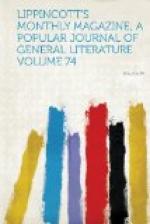CHARLES L. NORTON.
PAINTING AND A PAINTER.
Charles V. once said, “Titian should be served by Caesar;” and Michael Angelo, we read, was treated by Lorenzo de’ Medici “as a son;” Raphael, his contemporary, was great enough to revere him, and thank God he had lived at the same time. In England, in France, in Germany, in Italy, in Spain at this day, the poet and the painter stand hedged about by the divinity of their gifts, and the people are proud to recognize their kingship.
Has “Reverence, that angel of the world,” as Shakespeare beautifully says, forgot to visit America? Or must we consider ourselves less capable yet of delicate appreciation, such as older nations possess? Or are we over-occupied in gaining possession of material comforts and luxuries, and so forget to revere our poets and painters till it is too late, and the curtain has fallen upon their unobtrusive and often struggling earthly career? What a millennium will have arrived when we learn to be as faithful to our love as we are sincere!
Questions like these have been asked also in times preceding ours. Alfred de Musset wrote upon this subject in 1833, in Paris: “There are people who tell you our age is preoccupied, that men no longer read anything or care for anything. Napoleon was occupied, I think, at Beresina: he, however, had his Ossian with him. When did Thought lose the power of being able to leap into the saddle behind Action? When did man forget to rush like Tyrtaeus to the combat, a sword in one hand, the lyre in the other? Since the world still has a body, it has a soul.”
Monsieur Charles Blanc writes: “In order to have an idea of the importance of the arts, it is enough to fancy what the great nations of the world would be if the monuments they have erected to their faiths, and the works whereon they have left the mark of their genius, were suppressed from history. It is with people as with men—after death only the emanations of their mind remain; that is to say, literature and art, written poems, and poems inscribed on stone, in marble or in color.”
The same writer, in his admirable book, Grammaire des arts du dessin, from which we are tempted to quote again and again, says: “The artist who limits himself simply to the imitation of Nature reaches only individuality: he is a slave. He who interprets Nature sees in her happy qualities; he evolves character from her; he is master. The artist who idealizes her discovers in her or imprints upon her the image of beauty: this last is a great master.... Placed between Nature and the ideal, between what is and what must be, the artist has a vast career before him in order to pass from the reality he sees to the beauty he divines. If we follow him in this career, we see his model transform itself successively before his eyes.... But the artist must give to these creations of his soul the imprint of life, and he can only find this imprint in the individuals Nature has created. The two are inseparable—the type, which is a product of thought, and the individual, which is a child of life.”




